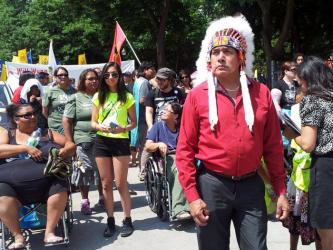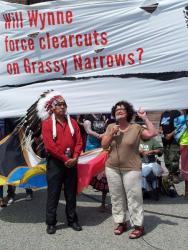Article Origin
Volume
Issue
Year
Members of Grassy Narrows First Nation, along with several hundred supporters, marched through downtown Toronto on July 31. To simulate a wild river, people carried fish cutouts and 1,500 meters of bright blue fabric rippling in the wind. They stopped traffic along University Avenue as they made their way to Queen’s Park. Grassy Narrows Chief Roger Fobister Sr., wearing a traditional headdress, led the walkers.
The march was one of several activities held during the week to garner support for the First Nation’s ongoing fight for the protection of their waters and homelands.
Grassy Narrows people are still suffering from the debilitating neurological impacts of 10 tonnes of mercury dumped into their river between 1962-1970 by a paper mill that was operating upstream. Most survivors are receiving inadequate health care and no compensation, according to an expert report commissioned in 2009 by the Mercury Disability Board. The board’s report was released to the public for the first time on July 28 by FreeGrassy.net.
Ontario and Canada have never apologized for even one case of mercury poisoning in Grassy Narrows. The report notes that 65 per cent of Grassy Narrows and White Dog First Nations people diagnosed with Minamata Disease by Japanese experts were not acknowledged by the Mercury Disability Board which uses outdated criteria developed in the 1980s. The Board includes representatives of both the federal and Ontario governments.
Steve Fobister Sr., a respected Grassy Narrows Elder and former grand chief of Treaty 3 suffers daily from the effects of mercury poisoning. Once a capable hunter and sport fishing guide, 63-year-old Fobister Sr. can now barely walk, trembles so severely that he has difficulty speaking and has lost sensation in his lips and fingers. He has lost his ability to make a living because of mercury poisoning and receives the paltry sum of $250 a month as compensation.
“By poisoning our river, and then clearcut logging our forests, Ontario has ruined our health and now threatens to destroy who we are,” Fobister said.
The Ontario provincial government has made final plans for a decade of clearcut logging on Grassy Narrows’ homeland against the community’s objections. Scientific studies indicate that clearcut logging in boreal watersheds raises mercury levels in fish above the World Health Organization’s limit for safe human consumption. Further mercury may be released if the Ontario government implements its current plan for more clearcutting.
Chief Roger Fobister Sr. said he felt the week in Toronto had been successful in shining a spotlight on his community’s concerns. The march was the finale in a week of activities, he said, “but this is not the end of it.” He said the government agreed to a meeting to discuss the mercury issue and the clean-up of the river.
Torontonians “provided very good support,” he said, pointing to the numbers of people on the march. “I haven’t seen anything negative,” he said “and even people on the street watching the march have been very supportive. They’re curious and haven’t made any negative comments.”
A recent Supreme Court decision was devastating and a major impact to the people of Grassy Narrows, he said.
“I thought the decision would build on top of the B.C. (Tsilquot’in) decision,” Fobister said, and was surprised when the top court ruled in favour of the Ontario government. The decision, he said, threatens Aboriginal and treaty rights and their survival in their own home territory.
“The Supreme Court decision allows the total jurisdiction of the province over even our treaty territory and that jurisdiction comes right up to the border of our community. My own home is just about two or three kilometers from the border,” he said. “The province licenses various companies to extract resources from that land and that could happen just two or three kilometers away from our community borders. The Supreme Court doesn’t talk about the duty to consult, so any time they want to cut down trees within our territory, they have to ask us now. That duty to consult, we regard, will be in the form of a table for government to government negotiations.”
Grassy Narrows is an Ojibwa First Nation located 80 km north of Kenora, Ont. It has a membership of about 1,600 people with just over 900 living in the community.
- 2863 views


